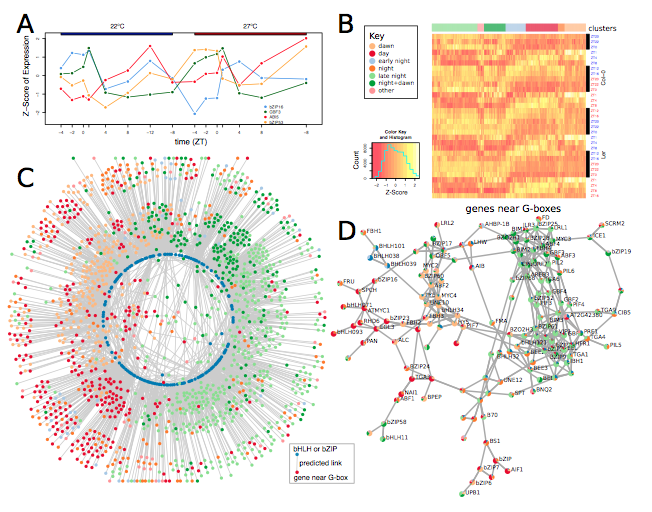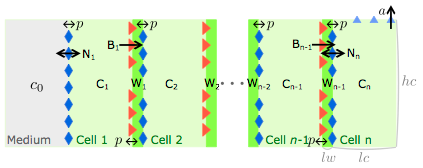After a brief hiatus the UK Arabidopsis Research Roundup returns with eight papers that focus on different aspects of Arabidopsis cell biology.
Firstly GARNet PI Jim Murray leads a study that performs a genome-wide analysis of sub-nucleosomal particles whilst Phil Wigge’s lab at SLCU conducts a more focused study on G-box regulatory sequences.
Thirdly Veronica Grieneisen (JIC) and co-workers have modelled the process of boron transport in the root, revealing exciting insights into how traffic jams might form.
Fourthly is a large scale biology paper led by Miriam Gifford (University of Warwick) that looks at the temporal and spatial expression patterns that control lateral root development.
Next Alexander Ruban (QMUL) investigates how low-light acclimated plants respond to high light.
The sixth and seventh studies are led by Alison Baker (Leeds) or Bill Davies (Lancaster) and look at phosphate or hormone signaling respectively.
Finally Gareth Jenkins (University of Glasgow) compares the UV-B signaling module in lower plants with that in Arabidopsis.
Pass DA, Sornay E, Marchbank A, Crawford MR, Paszkiewicz K, Kent NA, Murray JAH (2017) Genome-wide chromatin mapping with size resolution reveals a dynamic sub-nucleosomal landscape in Arabidopsis. PLoS Genet. doi: 10.1371/journal.pgen.1006988
Open Access
GARNet PI Jim Murray is the corresponding author on this study that performs a whole-genome scan of sub-nucleosomal particles (subNSPs) that have been identified using differential micrococcal nuclease (MNase) digestion. They link the position of subNSPs with RNAseq data taken from plants grown in different light conditions. They show that this new technique is able to discriminate regulatory regions that have been obscured by previous experimental procedures and therefore represents a very useful experimental method.
Ezer D, Shepherd SJ, Brestovitsky A, Dickinson P, Cortijo S, Charoensawan V, Box MS, Biswas S, Jaeger K, Wigge PA (2017) The G-box transcriptional regulatory code in Arabidopsis. Plant Physiol. 10.1104/pp.17.01086
Open Access

Phil Wigge (SLCU) is the corresponding author of this study that investigates the sequence elements that are linked to the conserved G-box regulatory motifs. They identify a set of bZIP and bHLH transcription factors that predict the expression of genes downstream of perfect G-boxes. In addition they have developed a website that provide visualisations of the G-box regulatory network (araboxcis.org).
Sotta N, Duncan S, Tanaka M, Takafumi S, Marée AF, Fujiwara T, Grieneisen VA (2017) Rapid transporter regulation prevents substrate flow traffic jams in boron transport. Elife. doi: 10.7554/eLife.27038
Open Access

Veronica Grieneisen (JIC) is the lead author on this detailed analysis of the regulatory circuits that are established during boron uptake in Arabidopsis roots. They used mathematical modelling to show that during boron uptake, swift regulation of transport activity is needed to prevent toxic accumulation of the metal. This system has analogy to the way in which traffic jams of nutrient flow might form and has relevance for regulatory systems outside of plant science. https://www.sciencedaily.com/releases/2017/09/170905104358.htm
Walker L, Boddington C, Jenkins D, Wang Y, Grønlund JT, Hulsmans J, Kumar S, Patel D, Moore JD, Carter A, Samavedam S, Bomono G, Hersh DS, Coruzzi GM, Burroughs NJ, Gifford ML (2017) Root architecture shaping by the environment is orchestrated by dynamic gene expression in space and time. Plant Cell. doi: 10.1105/tpc.16.00961
Open Access

Miriam Gifford (University of Warwick) leads this broad consortium that has taken a systems biology approach to better define the environmental factors that control dynamic root architecture. They track transcriptional responses during lateral root development in remarkable detail, looking at individual transcripts. They confirm the idea that the activity of a gene is not simply a function of its amino acid sequence but rather the temporal and spatial regulation of its expression.
Tian Y, Sacharz J, Ware MA, Zhang H, Ruban AV (2017) Effects of periodic photoinhibitory light exposure on physiology and productivity of Arabidopsis plants grown under low light. J Exp Bot. doi: 10.1093/jxb/erx213. Open Access

Alexander Ruban (QMUL) is the corresponding author on this collaboration with Chinese colleagues that examined the effect of high-light stress on low-light acclimated Arabidopsis plants. Initially these plants showed significant photo-inhibition but that they recovered rapidly and after 2 weeks of treatment there was no change in photosynthetic yield. In addition high light acclimated plants showed accelerated reproductive phase change that coincided with higher seed yield.
Qi W, Manfield IW, Muench SP, Baker A (2017) AtSPX1 affects the AtPHR1 -DNA binding equilibrium by binding monomeric AtPHR1 in solution. Biochem J. doi: 10.1042/BCJ20170522 Open Access
Alison Baker (University of Leeds) leads this research that focusses on the binding of the Phosphate Starvation Response 1 (PHR1) transcription factor to regulatory P1BS DNA sequences. They show a tandem P1BS sequence is bound more strongly than a single P1BS site. Ultimately they demonstrate tight regulation of phosphate signaling both by the concentration of phosphate as well as the activity of the interacting SPX protein.

Li X, Chen L, Forde BG, Davies WJ (2017) The Biphasic Root Growth Response to Abscisic Acid in Arabidopsis Involves Interaction with Ethylene and Auxin Signalling Pathways. Front Plant Sci. doi: 10.3389/fpls.2017.01493 Open Access
Bill Davies and Brian Forde (Lancaster University) lead this work that investigates the effect on ethylene and auxin on the biphasic response to ABA during root elongation. They used a range of hormone signalling mutants to show that the response to high ABA is via both ethylene and auzin signalling. In contrast the response to low ABA does not require ethylene signalling.
Soriano G, Cloix C, Heilmann M, Núñez-Olivera E, Martínez-Abaigar J, Jenkins GI (2017) Evolutionary conservation of structure and function of the UVR8 photoreceptor from the liverwort Marchantia polymorpha and the moss Physcomitrella patens. New Phytol. doi: 10.1111/nph.14767
Gareth Jenkins (University of Glasgow) is the corresponding author of this work that looks at the role of the UVR8 UV-B receptor in lower plants. They expressed the versions of UVR8 from a moss or a liverwort in Arabidopsis and showed that although there appears to be differences in the regulation of this protein, the mechanism of UV-B signaling is evolutionarily conserved





